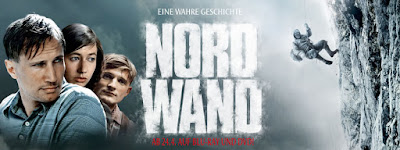
Climbing is really quite easy to do but notoriously hard to film. Anyone who has been involved in making even a small production of their own realises the logistical difficulties and the problem of making climbing 'interesting' - watching climbers move slowly over a rock face is a rather disembodied experience. And how on earth do you make movies about alpine climbs?!
I was thinking of the 'great' climbing movies (pointedly ignoring 'Cliffhanger') and my thoughts ran back to the excellent thriller The Eiger Sanction with Clint Eastwood and George Kennedy made during the Cold War hysteria in 1975. Since then there have been a few notable high-profile films such as the rather corny 1991 'mountain-buddy' movie K2, the superb Touching the Void by Kevin MacDonald in 2003 and now I think we have the best yet in 2009 - the superb Nordwand (North Face) directed by Philipp Stolzl.
Nordwand relates the tragic chain of events in July 1936 which led two talented German climbers (Toni Kurz and Andi Hinterstoisser) close to the first ascent of the Eiger north face, before turning back to help fellow climbers. The slowly unfolding tale of small errors and fateful combinations eats away at their goal as they try to ascend the mountain. Avalanches and rockfall and exposure threaten them all while the world's media looks on in macabre glee at the unfolding tale of tragedy through the hotels' telescopes. A well-crafted movie with great characterisation and a real feeling of exposure in the action sequences, with the constant ringing of hammered pitons in the background, this movie captures the ambiguous motivations of mountaineering but ends suitably with the purity of some climbers' sacrifices.